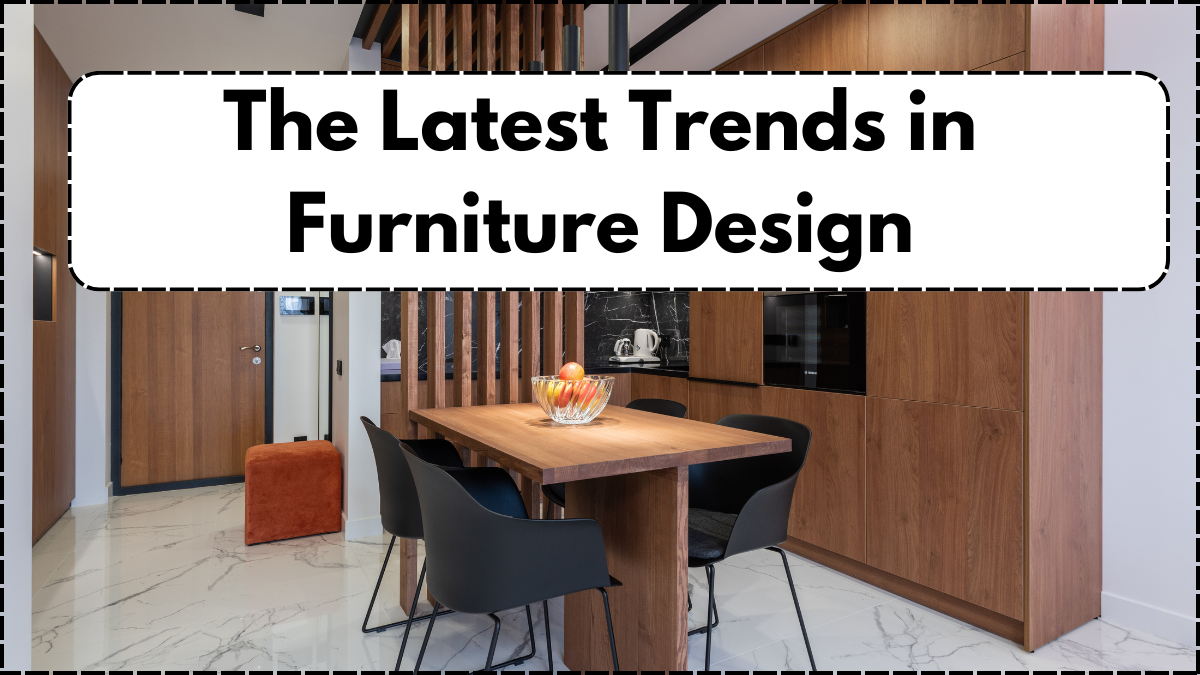Furniture design continues to evolve, reflecting shifts in lifestyle, technology, and environmental consciousness. Today’s trends balance aesthetics with practicality, emphasizing sustainability, modularity, and multifunctionality. Whether you’re furnishing a home, office, or commercial space, understanding these latest innovations can help you make informed choices.

The Latest Trends in Furniture Design
1. Sustainable and Eco-Friendly Designs
One of the biggest shifts in furniture design is the emphasis on sustainability. Consumers are more environmentally conscious, pushing designers to use recycled materials, ethically sourced wood, and non-toxic finishes. Brands are increasingly adopting reclaimed wood, bamboo, and recycled metals. Additionally, biodegradable upholstery fabrics and plant-based foams are gaining traction, reducing the carbon footprint of furniture production. Companies like IKEA and West Elm are leading the way by incorporating FSC-certified wood and eco-friendly materials into their collections.
2. Multifunctional and Modular Furniture
With urban living spaces shrinking, multifunctional furniture has become a necessity. Designers are creating adaptable pieces that serve multiple purposes, such as sofa beds, extendable dining tables, and storage-integrated seating. Modular furniture, which allows users to reconfigure pieces to suit different needs, is also gaining popularity. Brands like Muuto and Herman Miller are producing modular sofas and workstations that cater to flexible living and working environments.
3. Minimalist and Scandinavian Influences
Minimalism continues to be a dominant trend, with clean lines, neutral colors, and simple silhouettes defining modern furniture designs. Scandinavian aesthetics remain highly sought after, emphasizing functionality, light woods, and muted tones. The ‘Japandi’ style—a fusion of Japanese and Scandinavian design—is also trending, focusing on craftsmanship, natural materials, and a clutter-free environment.
4. Bold Colors and Statement Pieces
While minimalism prevails, there is also a rise in bold, expressive furniture. Vibrant hues, unique shapes, and striking materials are making statements in contemporary interiors. Jewel-toned velvets, curved sofas, and sculptural chairs add personality and a sense of luxury to modern spaces. Brands like Roche Bobois and Jonathan Adler are leading this trend with eye-catching designs that blend artistry with functionality.
5. Smart Furniture and Tech Integration
Technology is becoming an integral part of furniture design. Smart furniture now includes features like wireless charging stations, built-in speakers, and adjustable ergonomic settings. Office chairs with posture correction sensors, coffee tables with embedded touchscreens, and smart beds that monitor sleep patterns are just a few examples of how tech is enhancing furniture functionality. As homes become more connected, expect further integration of IoT (Internet of Things) into everyday furniture.
6. Retro and Vintage Revival
Mid-century modern and vintage-inspired designs are making a strong comeback. Furniture with tapered legs, rich wood tones, and curved edges reminiscent of the 1950s and 1960s is being reinterpreted for contemporary spaces. Vintage-style velvet armchairs, cane furniture, and terrazzo surfaces bring nostalgia with a modern twist, offering warmth and character to interiors.
7. Industrial and Raw Material Aesthetic
The industrial style, featuring raw materials like concrete, exposed steel, and reclaimed wood, remains a favorite among modern designers. Open shelving with metal frames, distressed finishes, and exposed hardware create a rugged yet sophisticated look. This aesthetic works well in urban lofts, offices, and contemporary homes seeking a touch of raw authenticity.
8. Biophilic Design and Organic Shapes
Bringing nature indoors through biophilic design is another growing trend. Furniture with organic, free-flowing shapes, earthy tones, and nature-inspired textures fosters a sense of calm and well-being. Live-edge wooden tables, rattan chairs, and furniture incorporating moss or plant elements create a harmonious connection between interiors and nature.
Conclusion
The latest furniture designs reflect a blend of innovation, sustainability, and personal expression. Whether you prefer minimalist elegance, bold statement pieces, or tech-enhanced functionality, today’s trends cater to a wide range of styles and needs. As design continues to evolve, the focus remains on creating furniture that enhances both form and function, making everyday spaces more adaptable, stylish, and sustainable.
Akesh is a furniture expert with years of experience in design and craftsmanship. Specializing in sustainable materials, he shares his expertise to help people create stylish and functional living spaces.
